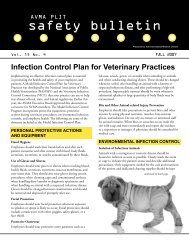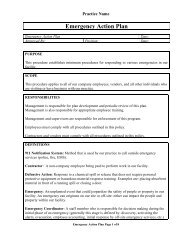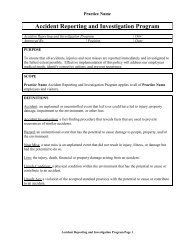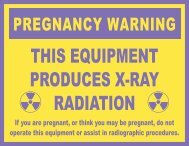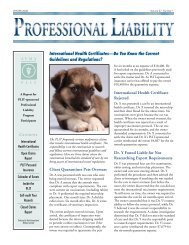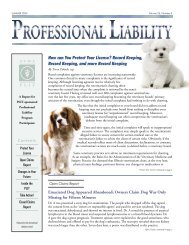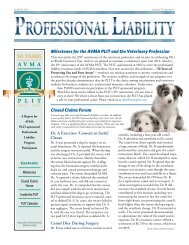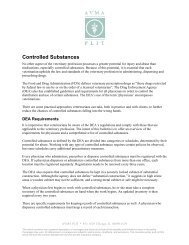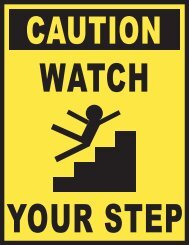§1904.6…Under the <strong>OSHA</strong> recordkeeping system, theemployer is always the responsible party when itcomes to making the determination of the recordabilityof a given case. However, if <strong>OSHA</strong> did not establishconsistent new case determination criteria, asubstantial amount of variability would be introducedinto the system, which would undermine theAgency’s goals of improving the accuracy and consistencyof the Nation’s occupational injury and illnessdata….…”[A]dopt a definition for new case that requiresthe occurrence of a new work-related event to triggera new case. In the absence of this, the case would beconsidered recurring.” …<strong>OSHA</strong> agrees… that if nofurther event or exposure occurs in the workplace toaggravate a previous injury or illness, a new caseneed not be recorded. However, if events or exposuresat work cause the same symptoms or signs torecur, the final rule requires employers to evaluatethe injury or illness to see if it is a new case and isthus recordable.The <strong>OSHA</strong> statistical system is designed to measurethe incidence, rather than prevalence, of occupationalinjury and illness. Incidence measures capturethe number of new occupational injuries and illnessesoccurring in a given year, while prevalence measurescapture the number of such cases existing in agiven year (prevalence measures thus capture caseswithout regard to the year in which they onset).Prevalence measures would therefore capture allinjuries and illnesses that occurred in a given year aswell as those unresolved injuries and illnesses thatpersist from previous years. The difference is illustratedby the following cases: (1) A worker experiencesa cut that requires sutures and heals completelybefore the year ends; this injury would be capturedboth by an incidence or prevalence measure for thatparticular year. (2) Another worker retired last yearbut continues to receive medical treatment for awork-related respiratory illness that was first recognizedtwo years ago. This case would be captured inthe year of onset and each year thereafter until itresolves if a prevalence measure is used, but wouldbe counted only once (in the year of onset) if an incidencemeasure is used.Because the <strong>OSHA</strong> system is intended to measurethe incidence of occupational injury and illness, eachindividual injury or illness should be recorded onlyonce in the system. However, an employee can experiencethe same type of injury or illness more thanonce. For example, if a worker cuts a finger on amachine in March, and is then unfortunate enough tocut the same finger again in October, this worker hasclearly experienced two separate occupationalinjuries, each of which must be evaluated for itsrecordability. In other cases, this evaluation is not assimple. For example, a worker who performs forcefulmanual handling injures his or her back in 1998,resulting in days away from work, and the case isentered into the records. In 1999 this worker hasanother episode of severe work-related back pain andmust once again take time off for treatment and recuperation.The question is whether or not the newsymptoms, back pain, are continuing symptoms ofthe old injury, or whether they represent a new injurythat should be evaluated for its recordability as anew case. The answer in this case lies in an analysisof whether or not the injured or ill worker has recoveredfully between episodes, and whether or not theback pain is the result of a second event or exposurein the workplace, e.g., continued manual handling. Ifthe worker has not fully recovered and no new eventor exposure has occurred in the workplace, the caseis considered a continuation of the previous injury orillness and is not recordable….…The term “new case” tends to suggest to somethat the case is totally original, when in fact newcases for <strong>OSHA</strong> recordkeeping purposes includethree categories of cases; (1) totally new cases wherethe employee has never suffered similar signs orsymptoms while in the employ of that employer, (2)cases where the employee has a preexisting conditionthat is significantly aggravated by activities atwork and the significant aggravation reaches thelevel requiring recordation, and (3) previously recordedconditions that have healed (all symptoms andsigns have resolved) and then have subsequentlybeen triggered by events or exposures at work.Under the former rule and the final rule, both newinjuries and recurrences must be evaluated for theirwork-relatedness and then for whether they meetone or more of the recording criteria; when these criteriaare met, the case must be recorded. If the caseis a continuation of a previously recorded case butdoes not meet the “new case” criteria, the employermay have to update the <strong>OSHA</strong> 300 Log entry if theoriginal case continues to progress, i.e., if the statusof the case worsens. For example, consider a casewhere an employee has injured his or her back liftinga heavy object, the injury resulted in medical treatment,and the case was recorded as a case withoutrestricted work or days away. If the injury does notheal and the employer subsequently decides toassign the worker to restricted work activity, theemployer is required by the final rule to change thecase classification and to track the number of days of42<strong>OSHA</strong> RECORDKEEPINGHANDBOOK
estricted work. If the case is a previous work-relatedinjury that did not meet the recording criteria andthus was not recorded, future developments in thecase may require it to be recorded. For example, anemployee may suffer an ankle sprain tripping on astep. The employee is sent to a health care professional,who does not recommend medical treatmentor restrictions, so the case is not recorded at thattime. If the injury does not heal, however, and a subsequentvisit to a physician results in medical treatment,the case must then be recorded….…In other words, a safety and health analysisshould give less weight to an injury or illness thathas a clear and relatively quick recovery withoutimpairment of any kind and an injury or illness that ischronic in nature or one that involves recurringepisodes that are retriggered by workplace events orexposures.Ignoring the fact that an occupational injury or illnessis a recurrence occasioned by an event or exposurein the workplace would result in an underestimateof the true extent of occupational injury and illnessand deprive employers, employees, and safetyand health professionals of essential information ofuse in illness prevention. The other extreme, requiringemployers to record on-going signs or symptomsrepeatedly, even in the absence of an event or exposurein the workplace, would result in overstating theextent of illness. In terms of the recordkeeping system,deciding how most appropriately to handle newcases requires a balanced approach that minimizesboth overrecording and underrecording. <strong>OSHA</strong> hasdealt with this problem in the final rule by carefullydefining the circumstances under which a chronicand previously recorded injury or illness must beconsidered closed and defining the circumstancesunder which a recurrence is to be considered a newcase and then evaluated to determine whether itmeets one or more of the recordability criteria….…The final rule uses one set of criteria for determiningwhether any injury or illness, including amusculoskeletal disorder, is to be treated as a newcase or as the continuation of an “old” injury or illness.First, if the employee has never had a recordedinjury or illness of the same type and affecting thesame part of the body, the case is automaticallyconsidered a new case and must be evaluated forrecordability. This provision will handle the vastmajority of injury and illness cases, which are newcases rather than recurrences or case continuations.Second, if the employee has previously had a recordedinjury or illness of the same type and affecting thesame body part, but the employee has completelyrecovered from the previous injury or illness, and anew workplace event or exposure causes the injuryor illness (or its signs or symptoms) to reappear, thecase is a recurrence that the employer must evaluatefor recordability.The implementation section of Section 1904.6describes these requirements and includes explanationsapplying to two special circumstances. In thefirst case, paragraph 1904.6(b)(1) the employee hasexperienced a chronic injury or illness of a type thatwill progress regardless of further workplace exposure.Cases to which this provision applies are serious,chronic illness conditions such as occupationalcancer, asbestosis, silicosis, chronic beryllium disease,etc. These occupational conditions generallycontinue to progress even though the worker isremoved from further exposure. These conditionsmay change over time and be associated with recurrencesof symptoms, or remissions, but the signs(e.g., positive chest roentgenogram, positive bloodtest) generally continue to be present throughout thecourse of the disease.The second kind of case, addressed in paragraph1904.6(b)(b)(2), requires employers to record chronicillness cases that recur as a result of exposures in theworkplace. These conditions might include episodesof occupational asthma, reactive airways dysfunctionsyndrome (RADS), or contact allergic dermatitis, forexample.Paragraph 1904.6(b)(3) recognizes the role ofphysicians and other licensed health care professionalsthat the employer may choose to rely on whentracking a “new case” or making a continuation of anold case determination. If a physician or otherlicensed health care professional determines that aninjury or illness has been resolved, the employermust consider the case to be resolved and record asa new case any episode that causes the signs andsymptoms to recur as a result of exposure in theworkplace. On the other hand, if the HCP consultedby the employer determines that the case is a chronicillness of the type addressed by paragraph1904.6(b)(1), the employer would not record the caseagain. In either case, the employer would evaluate itfor work-relatedness and then determine whether theoriginal entry requires updating or the case meetsthe recording criteria. Paragraph (b)(3) also recognizesthat the employer may ask for input from morethan one HCP, or the employer and employee mayeach do so, and in such cases, the rule requires theemployer to rely on the one judged by the employerto be most authoritative.§1904.6<strong>OSHA</strong> RECORDKEEPINGHANDBOOK43
- Page 1 and 2: www.osha.govOSHARecordkeepingHandbo
- Page 3 and 4: OSHARecordkeeping HandbookThe Regul
- Page 5 and 6: ContentsRecordkeeping HandbookRoadm
- Page 7 and 8: Section 1904.40Providing records to
- Page 10 and 11: §1904.0…OSHA has rejected the su
- Page 12 and 13: §1904.1Since publication of the re
- Page 14 and 15: §1904.2SIC code Industry descripti
- Page 16 and 17: §1904.2tinue to have injury and il
- Page 18 and 19: Section 1904.3Keeping records for m
- Page 20 and 21: PREAMBLE DISCUSSION: Section 1904.4
- Page 22 and 23: (viii)(ix)The illness is the common
- Page 24 and 25: §1904.5employment environment. For
- Page 26 and 27: §1904.5the employee’s status as
- Page 28 and 29: §1904.5Exceptions Proposed but Not
- Page 30 and 31: §1904.5pain and swelling in a join
- Page 32 and 33: §1904.5the worker has taken a side
- Page 34 and 35: §1904.526“Personal tasks” for
- Page 36 and 37: If the accident had occurred in a l
- Page 38 and 39: Scenario 4:• An employee reports
- Page 40 and 41: In applying [the presumption of wor
- Page 42 and 43: Letters of interpretation related t
- Page 44 and 45: November 19, 2002Joseph Woodward, E
- Page 46 and 47: Letter of interpretation related to
- Page 48 and 49: §1904.6that the two injuries or il
- Page 52 and 53: FREQUENTLY ASKED QUESTIONS: Section
- Page 54 and 55: Since the employee was not performi
- Page 56 and 57: In each of the eight scenarios in y
- Page 58 and 59: §1904.7other licensed health care
- Page 60 and 61: §1904.7that eliminates the routine
- Page 62 and 63: §1904.7pose. This paragraph also s
- Page 64 and 65: §1904.7Counting Lost Workdays When
- Page 66 and 67: §1904.7tors to such injuries and i
- Page 68 and 69: §1904.7This list of first aid trea
- Page 70 and 71: §1904.7visit to a health care prof
- Page 72 and 73: §1904.7However, as discussed above
- Page 74 and 75: §1904.766immediate recording of si
- Page 76 and 77: §1904.7strength? How is an employe
- Page 78 and 79: §1904.7or illness. The severity of
- Page 80 and 81: The first treatment is glue used to
- Page 82 and 83: Response: The employer would have t
- Page 84 and 85: Letter of interpretation related to
- Page 86 and 87: Letter of interpretation related to
- Page 88 and 89: §1904.8exposure” as these terms
- Page 90 and 91: ing blood and other potentially inf
- Page 92 and 93: standard. In some cases employers v
- Page 94 and 95: PART 1904—[AMENDED] (67 FR 77170,
- Page 96 and 97: §1904.1088OSHA RECORDKEEPINGcorrec
- Page 98 and 99: §1904.1090OSHA RECORDKEEPINGAwaren
- Page 100 and 101:
§1904.1092reasonable checks agains
- Page 102 and 103:
§1904.1094determination. Second, t
- Page 104 and 105:
FREQUENTLY ASKED QUESTIONS: Section
- Page 106 and 107:
Also, from time to time we update o
- Page 108 and 109:
§1904.11Section 1904.11Recording c
- Page 110 and 111:
§1904.11of causation applies to th
- Page 112 and 113:
§1904.12Thus, the total MSD count
- Page 114 and 115:
§1904.12current survey was designe
- Page 116 and 117:
§1904.29son’s blood or other pot
- Page 118 and 119:
§1904.29cern cases, and the list m
- Page 120 and 121:
§1904.29have also been designed to
- Page 122 and 123:
§1904.29with that entry and employ
- Page 124 and 125:
FREQUENTLY ASKED QUESTIONS: Section
- Page 126 and 127:
Section 1904.29(b)(10). In addition
- Page 128 and 129:
Section 1904.30Multiple business es
- Page 130 and 131:
fest themselves quickly and can be
- Page 132 and 133:
§1904.31The term “employee” me
- Page 134 and 135:
§1904.31companies, and other tempo
- Page 136 and 137:
Letter of interpretation related to
- Page 138 and 139:
Scenario 5:• An employee drives i
- Page 140 and 141:
Response: The log is to be kept for
- Page 142 and 143:
Section 1904.32Annual summary(66 FR
- Page 144 and 145:
§1904.32The company executive cert
- Page 146 and 147:
Deletions from the former rule....F
- Page 148 and 149:
I do want to make one further point
- Page 150 and 151:
sede any longer retention periods s
- Page 152 and 153:
Response: The controlling employer
- Page 154 and 155:
Section 1904.35Employee involvement
- Page 156 and 157:
§1904.351904 regulation to provide
- Page 158 and 159:
§1904.35tions on employees’ and
- Page 160 and 161:
employee, the employer must provide
- Page 162 and 163:
Thank you for your interest in occu
- Page 164 and 165:
Letter of interpretation related to
- Page 166 and 167:
Section 1904.36Prohibition against
- Page 168 and 169:
and section 1952.4 spells out the r
- Page 170 and 171:
§1904.38Section 1904.38Variances f
- Page 172 and 173:
§1904.38cited and the citation is
- Page 174 and 175:
§1904.39PREAMBLE DISCUSSION: Secti
- Page 176 and 177:
§1904.39FREQUENTLY ASKED QUESTIONS
- Page 178 and 179:
§1904.40maintains the records at a
- Page 180 and 181:
June 23, 2003Mr. Edwin G. Foulke, J
- Page 182 and 183:
Section 1904.41Annual OSHA injury a
- Page 184 and 185:
Section 1904.42Requests from the Bu
- Page 186 and 187:
Section 1904.43Summary and posting
- Page 188 and 189:
Section 1904.44Retention and updati
- Page 190 and 191:
Section 1904.45OMB control numbers
- Page 192 and 193:
allows him or her to independently
- Page 194 and 195:
§1904.46the three criteria above,
- Page 196 and 197:
§1904.46approach will provide an i
- Page 198 and 199:
FREQUENTLY ASKED QUESTIONS: Section
- Page 200 and 201:
Section 1952.4Injury and illness re



